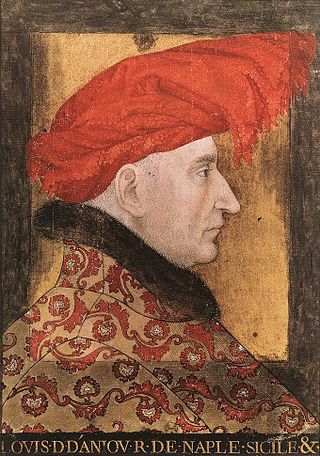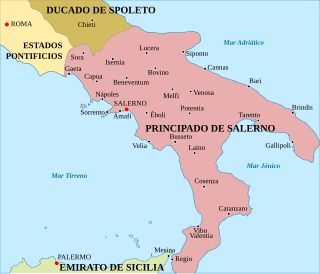Related Research Articles

Alfonso the Magnanimous was King of Aragon and King of Sicily and the ruler of the Crown of Aragon from 1416 and King of Naples from 1442 until his death. He was involved with struggles to the throne of the Kingdom of Naples with Louis III of Anjou, Joanna II of Naples and their supporters, but ultimately failed and lost Naples in 1424. He recaptured it in 1442 and was crowned king of Naples. He had good relations with his vassal, Stjepan Kosača, and his ally, Skanderbeg, providing assistance in their struggles in the Balkans. He led diplomatic contacts with the Ethiopian Empire and was a prominent political figure of the early Renaissance, being a supporter of literature as well as commissioning several constructions for the Castel Nuovo.

Pope Boniface IX was head of the Catholic Church from 2 November 1389 to his death, in October 1404. He was the second Roman pope during the Western Schism. In this time, the Avignon claimants, Clement VII and Benedict XIII, maintained the Roman Curia in Avignon, under the protection of the French monarchy. He is the last pope to date to take on the pontifical name "Boniface".

The Capetian House of Valois was a cadet branch of the Capetian dynasty. They succeeded the House of Capet to the French throne, and were the royal house of France from 1328 to 1589. Junior members of the family founded cadet branches in Orléans, Anjou, Burgundy, and Alençon.

Frederick II ; 13 December 1272 – 25 June 1337) was the regent of the Kingdom of Sicily from 1291 until 1295 and subsequently King of Sicily from 1295 until his death. He was the third son of Peter III of Aragon and served in the War of the Sicilian Vespers on behalf of his father and brothers, Alfonso ΙΙΙ and James ΙΙ. He was confirmed as king by the Peace of Caltabellotta in 1302. His reign saw important constitutional reforms: the Constitutiones regales, Capitula alia, and Ordinationes generales.

Ferdinand I, also known as Ferrante, was king of Naples from 1458 to 1494.

Joanna I, also known as Johanna I, was Queen of Naples, and Countess of Provence and Forcalquier from 1343 to 1381; she was also Princess of Achaea from 1373 to 1381.
Charles of Durazzo, also called Charles the Small, was King of Naples and the titular King of Jerusalem from 1382 to 1386 as Charles III, and King of Hungary from 1385 to 1386 as Charles II. In 1381, Charles created the chivalric Order of the Ship. In 1383, he succeeded to the Principality of Achaea on the death of James of Baux.

Robert I of Normandy, also known as Robert the Magnificent and by other names, was a Norman noble of the House of Normandy who ruled as duke of Normandy from 1027 until his death in 1035. He was the son of Duke Richard II; the brother of Duke Richard III, against whom he unsuccessfully revolted; and the father of Duke William who became the first Norman king of England after winning the Battle of Hastings in 1066. During his reign, Robert quarrelled with the church—including his uncle Robert, archbishop of Rouen—and meddled in the disorder in Flanders. He finally reconciled with his uncle and the church, restoring some property and undertaking a pilgrimage to Jerusalem, during which he died.

The House of Borgia was a Spanish noble family, which rose to prominence during the Italian Renaissance. They were from Xàtiva, Kingdom of Valencia, the surname being a toponymic from the town of Borja, then in the Crown of Aragon, in Spain.

Louis II was Duke of Anjou and Count of Provence from 1384 to 1417; he claimed the Kingdom of Naples, but only ruled parts of the kingdom from 1390 to 1399. His father, Louis I of Anjou—the founder of the House of Valois-Anjou—was a younger son of King John II of France and the adopted son of Queen Joanna I of Naples. When his father died during a military campaign in Naples in 1384, Louis II was still a child. He inherited Anjou from his father, but his mother, Marie of Blois, could not convince his uncles, John, Duke of Berry and Philip II, Duke of Burgundy, to continue her husband's war for Naples. The Provençal nobles and towns refused to acknowledge Louis II as their lawful ruler, but Marie of Blois persuaded them one after another to swear fealty to him between 1385 and 1387.

William of Jumièges was a contemporary of the events of 1066, and one of the earliest writers on the subject of the Norman conquest of England. He is himself a shadowy figure, only known by his dedicatory letter to William the Conqueror as a monk of Jumièges. Since he also mentions that he was an eyewitness of some events from the reign of Duke Richard III (1026-7), it seems reasonable to assume that he was born some time about the year 1000. He probably entered the monastery during the first quarter of the eleventh century and received his education from Thierry de Mathonville. According to Orderic Vitalis, William's nickname was "Calculus". The meaning behind this nickname is unknown. His death, after 1070, is unrecorded. He was a Norman writing from a Norman point of view. Although only a monk with evidently no military training, he wrote with pride in the accomplishments of his people.

Guaimar IV was Prince of Salerno (1027–1052), Duke of Amalfi (1039–1052), Duke of Gaeta (1040–1041), and Prince of Capua (1038–1047) in Southern Italy over the period from 1027 to 1052. He was an important figure in the final phase of Byzantine authority in the Mezzogiorno and the commencement of Norman power. He was, according to Amatus of Montecassino, "more courageous than his father, more generous and more courteous; indeed he possessed all the qualities a layman should have—except that he took an excessive delight in women."

Alfonso, also called Anfuso or Anfusus (c. 1120 – 10 October 1144), was the Prince of Capua from 1135 and Duke of Naples from 1139. He was an Italian-born Norman of the noble Hauteville family. After 1130, when his father Roger became King of Sicily, he was the third in line to the throne; second in line after the death of an older brother in 1138. He was the first Hauteville prince of Capua after his father conquered the principality from the rival Norman Drengot family. He was also the first Norman duke of Naples after the duchy fell vacant on the death of the last Greek duke. He also expanded his family's power northwards, claiming lands also claimed by the Papacy, although he was technically a vassal of the Pope for his principality of Capua.
Gregory IV was the firstborn son of Duke Sergius II of Naples and successor of his paternal uncle, Bishop Athanasius, in 898, when he was elected dux, or magister militum, unanimously by the aristocracy. His other paternal uncle, Stephen, succeeded Athanasius as bishop. According to the Chronicon ducum et principum Beneventi, Salerni, et Capuae et ducum Neapolis, he reigned for sixteen years and eight months.
Romuald II the Younger was the son of Gisulf I and Winiperga. He succeeded as duke of Benevento on the death of his father, which is dated variously as 698, 706, or 707. According to Paul the Deacon, Gisulf reigned 17 years, which would imply his death in 698, but Paul also mentions acts which seem certainly to have occurred around 705. He gives Romuald a reign of 26 years, which puts his death in either 724, 731, or 732.

The Principality of Capua was a Lombard state centred on Capua in Southern Italy. Towards the end of the 10th century the Principality reached its apogee, occupying most of the Terra di Lavoro area. It was originally a gastaldate, then a county, within the principality of Salerno.
Marinus I was the Duke of Naples from 919 to his death. He was the second son of Gregory IV and successor of his brother John II. The Chronicon ducum et principum Beneventi, Salerni, et Capuae et ducum Neapolis calls him Marianus. According to that document, he reigned eight years, nine months, and fifteen days.

The Capetian House of Anjou, or House of Anjou-Sicily, or House of Anjou-Naples was a royal house and cadet branch of the Capetian dynasty. It is one of three separate royal houses referred to as Angevin, meaning "from Anjou" in France. Founded by Charles I of Anjou, the youngest son of Louis VIII of France, the Capetian king first ruled the Kingdom of Sicily during the 13th century. The War of the Sicilian Vespers later forced him out of the island of Sicily, leaving him with the southern half of the Italian Peninsula, known as the Kingdom of Naples. The house and its various branches would go on to influence much of the history of Southern and Central Europe during the Middle Ages until it became extinct in 1435.

The Norman conquest of southern Italy lasted from 999 to 1194, involving many battles and independent conquerors. In 1130, the territories in southern Italy united as the Kingdom of Sicily, which included the island of Sicily, the southern third of the Italian Peninsula, the archipelago of Malta, and parts of North Africa.

Peter of Candia, also known as Peter Phillarges, named as Alexander V, was an antipope elected by the Council of Pisa during the Western Schism (1378–1417). He reigned briefly from 26 June 1409 to his death in 1410, in opposition to the Roman pope Gregory XII and the Avignon antipope Benedict XIII. In the 20th century, the Catholic Church reinterpreted the Western Schism by recognising the Roman popes as legitimate. Gregory XII's reign was extended to 1415, and Alexander V is now regarded as an antipope.